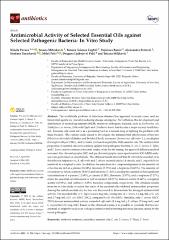Antimicrobial Activity of Selected Essential Oils against Selected Pathogenic Bacteria: In Vitro Study

View/
Date
2021Author
Puvača, Nikola
Milenković, Jovana
Galonja Coghill, Tamara
Bursić, Vojislava
Petrović, Aleksandra
Tanasković, Snežana
Pelić, Miloš
Ljubojević Pelić, Dragana
Miljković, Tatjana
Metadata
Show full item recordAbstract
The worldwide problem of infectious diseases has appeared in recent years, and antimicrobial agents are crucial in reducing disease emergence. Nevertheless, the development and
distribution of multidrug-resistant (MDR) strains in pathogenic bacteria, such as Escherichia coli,
Staphylococcus aureus, Salmonella Typhi and Citrobacter koseri, has become a major society health hazard. Essential oils could serve as a promising tool as a natural drug in fighting the problem with
these bacteria. The current study aimed to investigate the antimicrobial effectiveness of tea tree
(Melaleuca alternifolia (Maiden and Betche) Cheel), rosemary (Rosmarinus officinalis L.), eucalyptus
(Eucalyptus obliqua L’Hér.), and lavender (Lavandula angustifolia Mill) essential oils. The antimicrobial
properties of essential oils were screened against four pathogenic bacteria, E. coli, S. aureus, S. Tyhpi,
and C. koseri, and two reference bacterial strains, while for the testing, the agar well diffusion method
was used. Gas chromatography (GC) and gas chromatography–mass spectrometric (GC–MSD) analyses were performed on essential oils. The obtained results showed that M. alternifolia essential oil is
the richest in terpinen-4-ol, R. officinalis and E. oblique essential oils in 1,8-cineole, and L. angustifolia essential oil in α-terpinyl acetate. In addition, the main bioactive compounds present in the essential oil
of tea tree are rich in α-pinene (18.38%), limonene (7.55%) and γ-terpinene (14.01%). The essential oil
of rosemary is rich in α-pinene (8.38%) and limonene (11.86%); eucalyptus essential oil has significant
concentrations of α-pinene (12.60%), p-cymene (3.24%), limonene (3.87%), and γ-terpinene (7.37%),
while the essential oil of lavender is rich in linalool (10.71%), linalool acetate (9.60%), α-terpinyl
acetate (10.93%), and carbitol (13.05%) bioactive compounds, respectively. The obtained results
from the in vitro study revealed that most of the essential oils exhibited antimicrobial properties.
Among the tested essential oils, tea tree was discovered to demonstrate the strongest antimicrobial
activity. The recorded MIC of S. Typhi was 6.2 mg/mL, 3.4 mg/mL of C. koseri, 3.1 mg/mL of E. coli,
and 2.7 mg/mL of E. coli ATCC 25922, compared to M. alternifolia. Similarly, only S. aureus ATCC
25923 showed antimicrobial activity towards R. officinalis (1.4 mg/mL), E. oblique (2.9 mg/mL), and
L. angustifolia (2.1 mg/mL). Based on the obtained results, it is possible to conclude that tea tree
essential oil might be used as an ecological antimicrobial in treating infectious diseases caused by the
tested pathogens.
